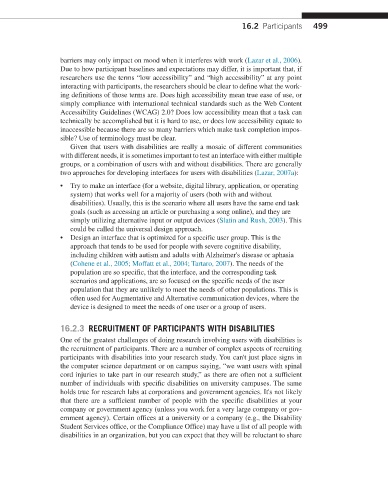Page 506 -
P. 506
16.2 Participants 499
barriers may only impact on mood when it interferes with work (Lazar et al., 2006).
Due to how participant baselines and expectations may differ, it is important that, if
researchers use the terms “low accessibility” and “high accessibility” at any point
interacting with participants, the researchers should be clear to define what the work-
ing definitions of those terms are. Does high accessibility mean true ease of use, or
simply compliance with international technical standards such as the Web Content
Accessibility Guidelines (WCAG) 2.0? Does low accessibility mean that a task can
technically be accomplished but it is hard to use, or does low accessibility equate to
inaccessible because there are so many barriers which make task completion impos-
sible? Use of terminology must be clear.
Given that users with disabilities are really a mosaic of different communities
with different needs, it is sometimes important to test an interface with either multiple
groups, or a combination of users with and without disabilities. There are generally
two approaches for developing interfaces for users with disabilities (Lazar, 2007a):
• Try to make an interface (for a website, digital library, application, or operating
system) that works well for a majority of users (both with and without
disabilities). Usually, this is the scenario where all users have the same end task
goals (such as accessing an article or purchasing a song online), and they are
simply utilizing alternative input or output devices (Slatin and Rush, 2003). This
could be called the universal design approach.
• Design an interface that is optimized for a specific user group. This is the
approach that tends to be used for people with severe cognitive disability,
including children with autism and adults with Alzheimer's disease or aphasia
(Cohene et al., 2005; Moffatt et al., 2004; Tartaro, 2007). The needs of the
population are so specific, that the interface, and the corresponding task
scenarios and applications, are so focused on the specific needs of the user
population that they are unlikely to meet the needs of other populations. This is
often used for Augmentative and Alternative communication devices, where the
device is designed to meet the needs of one user or a group of users.
16.2.3 RECRUITMENT OF PARTICIPANTS WITH DISABILITIES
One of the greatest challenges of doing research involving users with disabilities is
the recruitment of participants. There are a number of complex aspects of recruiting
participants with disabilities into your research study. You can't just place signs in
the computer science department or on campus saying, “we want users with spinal
cord injuries to take part in our research study,” as there are often not a sufficient
number of individuals with specific disabilities on university campuses. The same
holds true for research labs at corporations and government agencies. It's not likely
that there are a sufficient number of people with the specific disabilities at your
company or government agency (unless you work for a very large company or gov-
ernment agency). Certain offices at a university or a company (e.g., the Disability
Student Services office, or the Compliance Office) may have a list of all people with
disabilities in an organization, but you can expect that they will be reluctant to share

